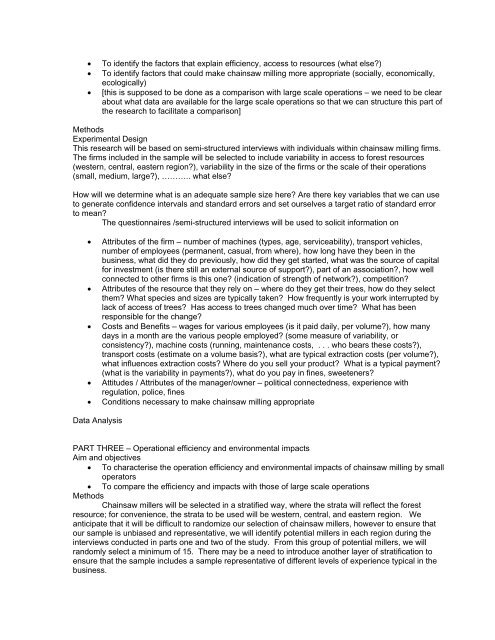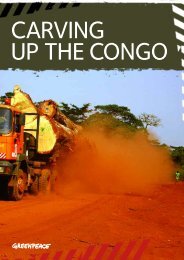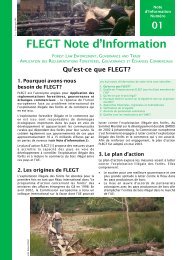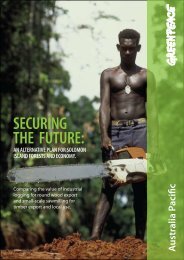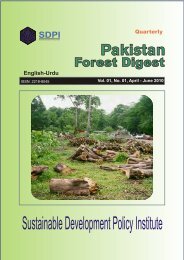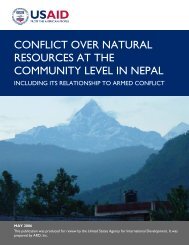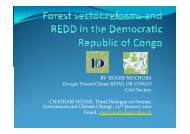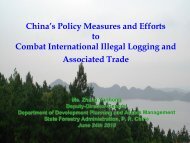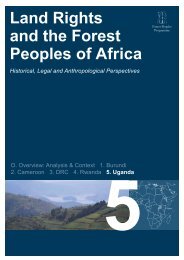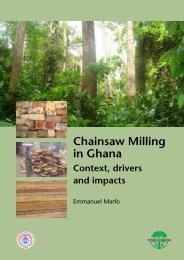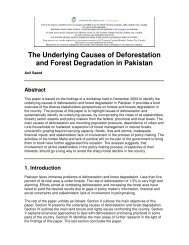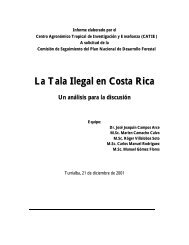household activity <strong>and</strong> economic reliance on <strong>cha<strong>in</strong>saw</strong> <strong>mill<strong>in</strong>g</strong> (objective 3). The <strong>in</strong>formation will helpscale up the results.It looks like we made need to work <strong>in</strong> a mim<strong>in</strong>um of 9 communities <strong>in</strong> Ghana (each status type<strong>in</strong> each of the three regions = 3 x 3 =9). To have an adequate estimate of variability with<strong>in</strong> eachcommunity, a target sample size may be 40 households, giv<strong>in</strong>g us a total of 360 households. If it isnecessary to reduce the total sample size, it would be better to reduce the number of householdssampled with<strong>in</strong> a community rather than reduce the number of communities sampled because theexpectation is that the variability <strong>in</strong> community-based or location factors will be more important <strong>in</strong>expla<strong>in</strong><strong>in</strong>g variability <strong>in</strong> the costs <strong>and</strong> benefits accru<strong>in</strong>g to rural people than are the household factors.If the community managed forests are to be <strong>in</strong>cluded, they would be <strong>in</strong> addition to the above 9; ifvillages with a migrant farmer population are to be <strong>in</strong>clude, they would also be <strong>in</strong> addition to the 9.Sample size – how will we determ<strong>in</strong>e when we have a sufficient sample? For the costs <strong>and</strong>benefits, with<strong>in</strong> a community, when you have stop gett<strong>in</strong>g new <strong>in</strong>formationThe questionnaires /semi-structured <strong>in</strong>terviews will be used to solicit <strong>in</strong>formation on current <strong>and</strong>historical <strong>in</strong>formation on household resource use, sources of <strong>in</strong>come, physical <strong>and</strong> non-physical assets,family demographics <strong>and</strong> migration, environmental conditions, changes, shocks or uncontrollableevents that have <strong>in</strong>fluenced the livelihood options.There will be sections of the questionnaire dedicated to the follow<strong>in</strong>g aspects:Household attributes / family members / assets /Community-level attributes / forest or tree resource / governance structureBenefits associated with forests, logg<strong>in</strong>g <strong>and</strong> <strong>mill<strong>in</strong>g</strong> (<strong>in</strong>clud<strong>in</strong>g economic reliance)Costs associated with forests, logg<strong>in</strong>g <strong>and</strong> <strong>mill<strong>in</strong>g</strong>Attitudes around forest resource management <strong>and</strong> protection (of the household, <strong>and</strong> thehousehold’s perspective of the wider community, of the chief <strong>and</strong> assemblyman – thelater might need to be confirmed by triangulation)Conditions necessary to make <strong>cha<strong>in</strong>saw</strong> <strong>mill<strong>in</strong>g</strong> socially susta<strong>in</strong>able? (would it be worth try<strong>in</strong>gto <strong>in</strong>corporate a section for only those households that are directly <strong>in</strong>volved to ask themto rank the changes that need to be made to make <strong>cha<strong>in</strong>saw</strong> <strong>mill<strong>in</strong>g</strong> more useful fortheir livelihoods?)Data AnalysisA profile of the households <strong>in</strong>terviewed will be developed by summariz<strong>in</strong>g household attributesacross the regions <strong>and</strong> forest status types. The types of costs <strong>and</strong> benefits associated with the twotypes of <strong>mill<strong>in</strong>g</strong> activities will be described <strong>and</strong> compared qualitatively. The proportion of householdsrealis<strong>in</strong>g each type of cost <strong>and</strong> benefit will be calculated <strong>and</strong> summarized by community. The extent ofhousehold activity <strong>in</strong> logg<strong>in</strong>g <strong>and</strong> <strong>mill<strong>in</strong>g</strong>, whether small scale <strong>cha<strong>in</strong>saw</strong> operations or large scaleoperations will be calculated as the number of households <strong>and</strong> proportion of households <strong>in</strong>terviewed.Economic reliance is def<strong>in</strong>ed as the relative importance of a particular activity as an <strong>in</strong>comesource or a form of <strong>in</strong>surance. We will calculate economic reliance by household on 1) large-scalelogg<strong>in</strong>g <strong>and</strong> <strong>mill<strong>in</strong>g</strong>, 2) small-scale <strong>cha<strong>in</strong>saw</strong> <strong>mill<strong>in</strong>g</strong>, 3) forest product use. We compared the meaneconomic reliance among the three regions (<strong>west</strong>, central, east) <strong>and</strong> by the status of the forest(protected, managed, farml<strong>and</strong>) us<strong>in</strong>g analysis of variance.A multivariate analysis will be used to identify the variables that are more strongly associatedwith household activity <strong>and</strong> economic reliance on large-scale logg<strong>in</strong>g <strong>and</strong> <strong>mill<strong>in</strong>g</strong>, small-scale <strong>cha<strong>in</strong>saw</strong><strong>mill<strong>in</strong>g</strong>, <strong>and</strong> forest product use. Bivariate correlation analyses will be conducted on pairs of variables todescribe the strength of associations amongst variables. (We could also use regression analyses to dothis, the characteristics of the data will determ<strong>in</strong>e what approach is more appropriate).PART TWO – Cha<strong>in</strong>saw Mill<strong>in</strong>g FirmsAim <strong>and</strong> objectives• To exam<strong>in</strong>e the economics of <strong>cha<strong>in</strong>saw</strong> logg<strong>in</strong>g <strong>and</strong> <strong>lumber</strong><strong>in</strong>g <strong>and</strong> the environmental <strong>and</strong>ecological impacts as they compare with large scale operations;• To characterise the distribution of costs <strong>and</strong> benefits with<strong>in</strong> a firm• To characterise the variability <strong>in</strong> costs <strong>and</strong> benefits across firms
• To identify the factors that expla<strong>in</strong> efficiency, access to resources (what else?)• To identify factors that could make <strong>cha<strong>in</strong>saw</strong> <strong>mill<strong>in</strong>g</strong> more appropriate (socially, economically,ecologically)• [this is supposed to be done as a comparison with large scale operations – we need to be clearabout what data are available for the large scale operations so that we can structure this part ofthe research to facilitate a comparison]MethodsExperimental DesignThis research will be based on semi-structured <strong>in</strong>terviews with <strong>in</strong>dividuals with<strong>in</strong> <strong>cha<strong>in</strong>saw</strong> <strong>mill<strong>in</strong>g</strong> firms.The firms <strong>in</strong>cluded <strong>in</strong> the sample will be selected to <strong>in</strong>clude variability <strong>in</strong> access to forest resources(<strong>west</strong>ern, central, eastern region?), variability <strong>in</strong> the size of the firms or the scale of their operations(small, medium, large?), ……….. what else?How will we determ<strong>in</strong>e what is an adequate sample size here? Are there key variables that we can useto generate confidence <strong>in</strong>tervals <strong>and</strong> st<strong>and</strong>ard errors <strong>and</strong> set ourselves a target ratio of st<strong>and</strong>ard errorto mean?The questionnaires /semi-structured <strong>in</strong>terviews will be used to solicit <strong>in</strong>formation on• Attributes of the firm – number of mach<strong>in</strong>es (types, age, serviceability), transport vehicles,number of employees (permanent, casual, from where), how long have they been <strong>in</strong> thebus<strong>in</strong>ess, what did they do previously, how did they get started, what was the source of capitalfor <strong>in</strong>vestment (is there still an external source of support?), part of an association?, how wellconnected to other firms is this one? (<strong>in</strong>dication of strength of network?), competition?• Attributes of the resource that they rely on – where do they get their trees, how do they selectthem? What species <strong>and</strong> sizes are typically taken? How frequently is your work <strong>in</strong>terrupted bylack of access of trees? Has access to trees changed much over time? What has beenresponsible for the change?• Costs <strong>and</strong> Benefits – wages for various employees (is it paid daily, per volume?), how manydays <strong>in</strong> a month are the various people employed? (some measure of variability, orconsistency?), mach<strong>in</strong>e costs (runn<strong>in</strong>g, ma<strong>in</strong>tenance costs, . . . who bears these costs?),transport costs (estimate on a volume basis?), what are typical extraction costs (per volume?),what <strong>in</strong>fluences extraction costs? Where do you sell your product? What is a typical payment?(what is the variability <strong>in</strong> payments?), what do you pay <strong>in</strong> f<strong>in</strong>es, sweeteners?• Attitudes / Attributes of the manager/owner – political connectedness, experience withregulation, police, f<strong>in</strong>es• Conditions necessary to make <strong>cha<strong>in</strong>saw</strong> <strong>mill<strong>in</strong>g</strong> appropriateData AnalysisPART THREE – Operational efficiency <strong>and</strong> environmental impactsAim <strong>and</strong> objectives• To characterise the operation efficiency <strong>and</strong> environmental impacts of <strong>cha<strong>in</strong>saw</strong> <strong>mill<strong>in</strong>g</strong> by smalloperators• To compare the efficiency <strong>and</strong> impacts with those of large scale operationsMethodsCha<strong>in</strong>saw millers will be selected <strong>in</strong> a stratified way, where the strata will reflect the forestresource; for convenience, the strata to be used will be <strong>west</strong>ern, central, <strong>and</strong> eastern region. Weanticipate that it will be difficult to r<strong>and</strong>omize our selection of <strong>cha<strong>in</strong>saw</strong> millers, however to ensure thatour sample is unbiased <strong>and</strong> representative, we will identify potential millers <strong>in</strong> each region dur<strong>in</strong>g the<strong>in</strong>terviews conducted <strong>in</strong> parts one <strong>and</strong> two of the study. From this group of potential millers, we willr<strong>and</strong>omly select a m<strong>in</strong>imum of 15. There may be a need to <strong>in</strong>troduce another layer of stratification toensure that the sample <strong>in</strong>cludes a sample representative of different levels of experience typical <strong>in</strong> thebus<strong>in</strong>ess.


